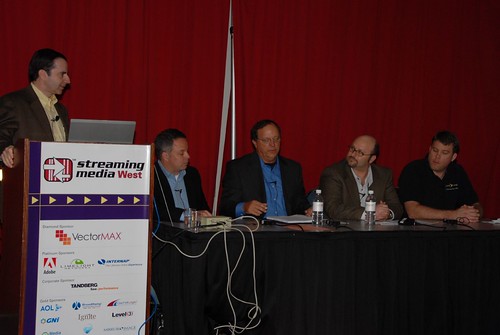Last month I took part in a panel discussion on, "Best Practices For Webcasting Production" at Streamingmedia West. Each speaker presented unique business case examples which shared common production processes and tools.
Click here to view the video in a new window. Thank you to Scribemedia.org for making the sessions available and a big thanks to the video crews who recorded all the sessions.
Click here to view the video in a new window. Thank you to Scribemedia.org for making the sessions available and a big thanks to the video crews who recorded all the sessions.
"This session delves into the intricacies and best practices of live broadcasting over the Internet. From signal acquisition to encoding and server distribution, the session will detail the best practices for delivering a live Internet Webcast. Discover how to deconstruct a complex and rich live event down to its elemental parts, from hardware and software to the workflow and signal flow of the production. Industry experts and end-users will share experiences and guidelines to help you produce successful, high-quality Internet broadcasts."
Speakers (pictured left to right)
(Moderator) Joe Tripician, Director of Broadband Services, Medialink
Gordon Castle, SVP, Turner Broadcasting/CNN
Wayne Oates, Global Web Communications Manager, McDonald's Corporation
Larry Kless, Production Manager, Videoconferencing, Kaiser Permanente Northern California
Alan Richardson, Webcast Program Manager, Sprint Creative Media
I've included the slide deck from the session below (my slides are 26-42):
Here are some "best practices" I've learned that address the technical and logistical challenges for webcasting, and how you put the right team and the right technology in place.
If you are producing a webcast, consider the following:
- Know your role. You may be producer, director and technical director and even camera all rolled up into one. Or you may have the luxury of hiring a full crew.
- Get clients on board with deadlines, financial commitments and better understanding of web cast requirements.
- Audio is the number one killer. It’s an ongoing issue when using wireless microphones, telephone call ins, multi-point conferencing and live PA (Public Address) system.
- Working with a team you know and trust and who knows your business is best. Relationships are vital to your process. Delegation and deference to expertise key to getting the job done. You need to rely on your team to do their job and sometimes take over your chores too when you get called away to manage client issues and handle last minute changes.
- Redundant personnel and technology is a must and equipment failure should be expected. Back up to you back ups really saves the day in a pinch.
- Make every room a broadcast studio.
- Site surveys at least a good 8 weeks ahead to inspect data and A/V ports, power requirements for lighting, ceiling height for rigging, windows and doors for light and noise, bring a digital camera, measuring tape and a continuity tester as part of your arsenal
- Complete all pre-web cast equipment and connectivity testing well in advance and conduct it on-site for higher reliability
- Prepare a production summary that includes every last bit of detail that covers the entire production. Give everyone on the crew a copy for reference and lead a production meeting before the works so that all teams are synched up.
- Be prepared for last minute changes and if there’s time just roll with them – update your script, rehearse if possible, but say “No, we’re out of time” when you have to. Really, there’s nothing worse than a major on-air blunder. But as they, “It’s live television.”
UPDATE:
- I've included the video from panel discussion now that it's available in an embedded player,


No comments:
Post a Comment